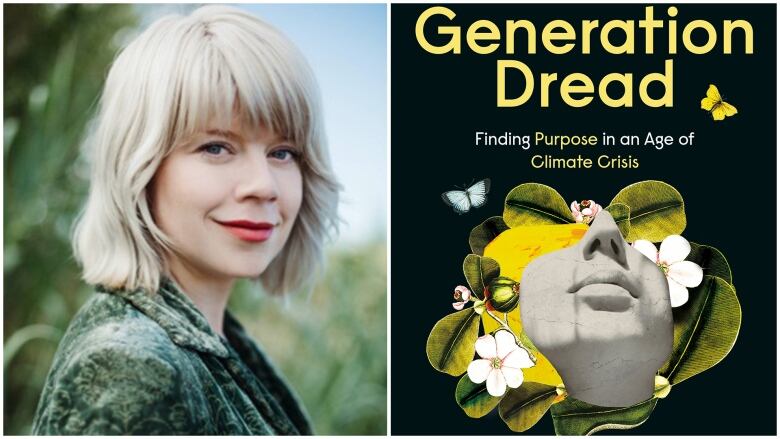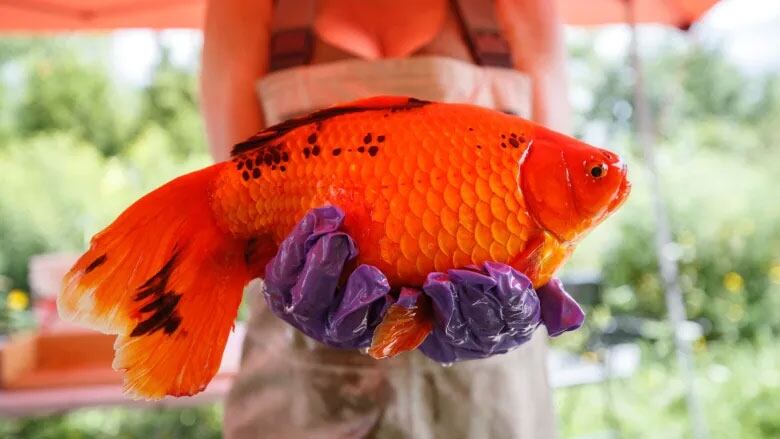How to turn climate anxiety into 'a tool, not a dead end'
Also: Feral goldfish!

Our planet is changing. So is our journalism. This weekly newsletter is part of a CBC News initiative entitled "Our Changing Planet" to show and explain the effects of climate change. Keep up with the latest news on ourClimate and Environment page.
Sign up hereto get this newsletter in your inbox everyThursday.
This week:
- How to turn climate anxiety into 'a tool, not a dead end'
- The human danger of extreme heat in India and Pakistan
- Ontario's feral goldfish population is exploding and climate change may be to blame
How to turn climate anxiety into 'a tool, not a dead end'


When Britt Wray and her husband started talking, back in 2017, about trying to have a baby, she found herself overwhelmed with anxiety and grief. Originally from Toronto, Wray was working as a science writer at the time and had been deeply engaged in reading climate reports. The idea of bringing a child into the world brought her to tears on many occasions. "I was that person you never want to be, crying out loud on public transport," Wray told What On Earth host Laura Lynch.
This "profound emotional turbulence" changed the course of her career. Wray is now a postdoctoral fellow in human and planetary health at Stanford University and the London School of Hygiene and Tropical Medicine. Her new book, Generation Dread: Finding Purpose in an Age of Climate Crisis, lays out a strategy for turning difficult emotions about climate change into "a tool, not a dead end."
Q: As someone who lives and breathes the science side of climate change, how did you square what you knew rationally with the way you were feeling?
A: It takes a lot of time to internally process these emotions because they're pretty existential in their nature. They can really make a person feel like the world isn't safe anymore if they were ever lucky enough to feel that the world is a safe place. Many people, of course, are not so privileged to be able to take that for granted.
And so I needed to come to cope with these emotions by doing the research for the book and finding out about how eco-anxiety is showing up in other people's lives and looking for diverse ways of grappling with the emotions.
I learned to value them and really see that eco-anxiety is a sign that we care and that we are compassionate and awake to what's happening, that we can sense the vulnerability of other species, many humans and the Earth itself.
We know that anxiety can be really constructive. But if we aren't supported in processing it with a group [of others who understand], for example, then it can lead to paralysis and immobilization, a sense of fatalism or doom, which becomes its own self-fulfilling prophecy.
Q: There are people living around the world where climate change is just one of the things that threatens lives and has done so for quite a long time. What is the responsibility of people who live with privilege when it comes to the climate crisis?
A: I think that privileged people ought to know that their feelings are valid. The fear and the anxiety and grief it's nothing to be ashamed of.
However, becoming so inwardly focused is really going to hurt rather than help in this crisis if we don't use the emotions to glean a sense of [our own] implication in this crisis and be able to look outwards towards who's really most vulnerable here and what we can do to supportively partner with them and work for climate justice.
Q: You caution about jumping straight from climate anxiety into climate activism. Where's the danger in that?
A: Banding together with others to make change in your communities or at whatever political level where you're pushing helps you narrow the gap between your values and your actions. Narrowing that gap by taking action can create a huge amount of psychological relief. Also, activism can bring people together with others and forge meaningful community support, which is huge.
However there's a lot of people writing articles about how to get over your eco-anxiety or beat back eco-anxiety and that is what gets it wrong. We need to learn to value [eco-anxiety] and fold it into our lives in a way that helps us develop emotional resilience.
We need much more external activism at all levels from all people. However, if our actions aren't paying off, if we continue to see leaders not heed our demands and emissions continue to rise and the world continue to burn, that's a very painful thing.
And so we also need to pay attention to our emotions and our feelings which is where we can really cultivate the resilience that will help us deal with the aftershocks of trauma and loss as we continue to bear witness to them in the climate crisis.
Rachel Sanders
This interview has been edited and condensed.
Reader feedback
Last week, Emily Chung wrote about yard-sharing initiatives across the country.
Bob Scott:
"Sharing gardens is a wonderful idea. I would like to take it one step further. Get the neighbourhood together and decide who ought to grow what. As an example, one garden could grow potatoes and nothing but. Another, onions, just one type. Another yard, another onion. Then garlic, tomatoes, peppers, squash.... the list goes on. Those who lack certain knowledge of how to plant, cultivate, fertilize, water and harvest their vegetables would learn the ropes quickly and all would benefit from the exercise and experience.
"As well, those who prefer flowers could share their gardens for a similar purpose. Again, everyone would learn and delight in the outcome."
MildredThill:
"I was disappointed in your yard share article. The bare soil you featured in the photograph does not show the best environmental practices. The University of Saskatchewan teaches no-till gardening and this is by far the most environmentally regenerative method. No-till preserves the spaces and layers in soil, allowing the soil to better hold moisture and air for the microbiology below the surface. Tillage is akin to taking a nice layer cake and turning it into crumbs. It blows away, washes away and does not absorb precipitation."
Liana and Duncan at City Beet Farm responded:
"What we do is considered 'low till,' which in our case means that we only use a broad fork and a wheel hoe to do a small amount of tilling to the top layer of soil. This maintains soil structure and biome while helping us prepare our beds for planting by letting in some air and integrating the compost we add. We have lots of admiration for no-till farmers, and agree that it is a beautiful, regenerative approach to agriculture. The photo in the article was taken early in the season. The cucumbers and gourds pictured grew to be much bigger over the course of the season, providing a lot more ground cover than what you see here."
Harold Nesbitt:
"What do neighbours think of the idea? Rows planted the wrong direction in [the picture with the article]. When it rains, dirt gets washed to the street, then down the storm sewer. Whoever posted the picture doesn't know anything about runoff."
Liana and Duncan at City Beet Farm:
"From what we hear, the neighbours love our gardens! One of the wonderful things about gardening, especially in a low- or no-till way, is that it actually increases soil permeability. It sounds like you're picturing great rivers of water flowing off our yards, when in fact rainwater is absorbed into our beds and pathways, and slurped up by our veggies and flowers. The scenario you mentioned of soil being swept out of our yards and into storm drains has yet to happen at one of our sites."
Write us atwhatonearth@cbc.ca.
Old issues of What on Earth? are right here.
***NEW***CBC News recently launched a dedicated climate page, which can be found here.
There's also a radio show and podcast!For more than 20 years, Suruchi Bhadwal has worked with vulnerable people in India, such as farmers and agricultural labourers, to help them adapt to a warming world. Now, as a major heat wave rolls through parts of the country, Bhadwal tells What On Earth host Laura Lynch of the efforts underway to keep people safe and what impact this heat wave will have on global food systems. What On Earth now airs on Sunday at 11 a.m. ET, 11:30 a.m. in Newfoundland and Labrador. Subscribe on your favourite podcast app or hear it on demand at CBC Listen.
The Big Picture:Extreme heat in India and Pakistan
We've been told again and again that some parts of the world will experience climate change more acutely than others. Right now, India and Pakistan provide a searing example of that. The subcontinent is going through a spell of extreme heat that is setting temperature records New Delhi had a run of days above 43 C, while Nawabshah and Jacobabad, both in Pakistan, have exceeded 49 C. And it's only the beginning of May.
Air conditioning units are not common in these parts, which means that Indians and Pakistanis have little refuge from the punishing heat. Some estimate the current heat wave is putting a billion people at risk of health problems, and it's spurring some climate scientists to wonder: what temperature is the limit for human survivability?
As the likelihood of extreme heat increases, one aspect getting greater attention is "wet-bulb temperatures." Technically, it's when water stops evaporating from a wet thermometer bulb, meaning it can no longer cool. This experiment is actually a stand-in for human sweat. The human body cools itself through perspiration, a process that relies on evaporation. But when there's too much humidity in the surrounding air, evaporation can no longer occur and the human body can no longer cool down.
- Do you have a question about climate change and what is being done about it? Send an email toask@cbc.ca

Hot and bothered: Provocative ideas from around the web
-
One of the selling features of electric vehicles, besides the emissions savings, is that there is less maintenance involved. But as a writer for Fortune magazine found out, you might need to change the tires more often.
-
Community groups in the U.K. want to be able to garden in underused spaces such as hospital grounds and road verges. They're asking for a law that would require authorities to keep a registry of public land suitable for vegetable and fruit-growing, which local groups could apply to access.
- Mangroves and seagrass are underappreciated for their ability to sequester carbon they're able to store three to five times more per hectare than tropical forests. With that in mind, the Bahamas is offering a program in which companies can pay to offset carbon in the country's coastal ecosystems.
- A number of individuals have taken extreme action to raise awareness of the climate crisis, from fasting to setting themselves on fire. This interview with B.C. hunger striker Howard Breen explores the psychological aspect of such efforts and whether they ultimately work.
Ontario's feral goldfish population is exploding and climate change may be to blame

For years, Andrew Murray has seen small schools of goldfish living in the storm pond near his home in suburban London, Ont. He never thought much of them until a sunny day last month when the normally greenish pond had an unusual, slightly orange tinge.
An avid nature photographer, Murray captured a few close-ups. It wasn't until he got home and looked at the pictures that he realized how many goldfish must be swimming around in there.
"When I looked at them on my computer later, it was clear there were just thousands and thousands of fish in there."
Researchers at the University of Toronto believe this scenario is repeating itself in suburban storm ponds all over the province. Originally built to reduce neighbourhood flooding and relieve pressure on Ontario's city sewer systems, these pools have become ground zero for what Nicholas Mandrak calls "super invaders."
"What we're seeing is the proliferation of goldfish in suburbs across southern Ontario, in fact across Canada," said Mandrak, a U of T professor who studies freshwater fish conservation.
With infestations reported in Alberta, B.C., Saskatchewan, Manitoba and in the United States, goldfish are quickly becoming one of North America's most prolific invasive species. The reason they're so widespread is based a lot on how people think of them as harmless and disposable.
"The people who release goldfishes into urban ponds may think they're doing a good thing: 'I'm not killing a creature,'" Mandrak said. But "there shouldn't be any fishes in these urban ponds."
Once introduced into a storm pond, the goldfish start feeding on the insects that would normally colonize it. They spawn rapidly, and their numbers, combined with their broad appetites, mean they compete with amphibians and other creatures, lowering the diversity of the native species.
They also escape when the ponds flood, releasing the fish into wetlands, creeks, rivers and lakes where Mandrak said goldfish become predators, eating the eggs and fry of other fish.
Goldfish also root, almost like an aquatic version of a pig, destroying habitat by loosening plants and muddying the water for rare and endangered native species such as the spiny softshell turtle, greenside darter and rainbow mussel.
According to Mandrak, goldfish have been in Ontario's wild waterways since the 19th century. What's changed is the sheer number of them, and he said it likely has to do with the recent addition of suburban storm water ponds and a changing climate, which offer the fish more favourable conditions to thrive.
"The Great Lakes waters and urban ponds warm up [more] than they would have previously. The water appears to be more suitable for goldfish.
"As the conditions become more extreme that is, water that is warm and low on oxygen one of the few fish that really do well in that type of habitat is goldfish."
It's why Mandrak believes goldfish deserve our attention. Not only are we releasing them into the wild, but human-caused climate change is also creating the conditions for them to thrive, through warmer water and spread to nearby wetlands through flooding caused by more intense rainfall.
Part of Mandrak's research involves trying to chart the lifecycle of a goldfish infestation in storm ponds that is, how many generations it takes before the fish take over a body of water.
Scientists can determine the amount of time a goldfish infestation has been in a body of water by the size of the largest fish, which, unconfined by the size of their bowls, have been known to grow to the size of a two-litre pop bottle and weigh up to two kilograms.
"Last year, we sampled a pond that was 100 metres by 100 metres, and it contained approximately 20,000 goldfish," Mandrak said. "We figured they'd been in there for between five and 10 years."
Colin Butler
Stay in touch!
Are there issues you'd like us to cover? Questions you want answered? Do you just want to share a kind word? We'd love to hear from you. Email us atwhatonearth@cbc.ca.
Sign up hereto getWhat on Earth?in yourinbox every Thursday.
Editor: Andre Mayer | Logo design: Skdt McNalty













_(720p).jpg)


 OFFICIAL HD MUSIC VIDEO.jpg)
.jpg)



























































































